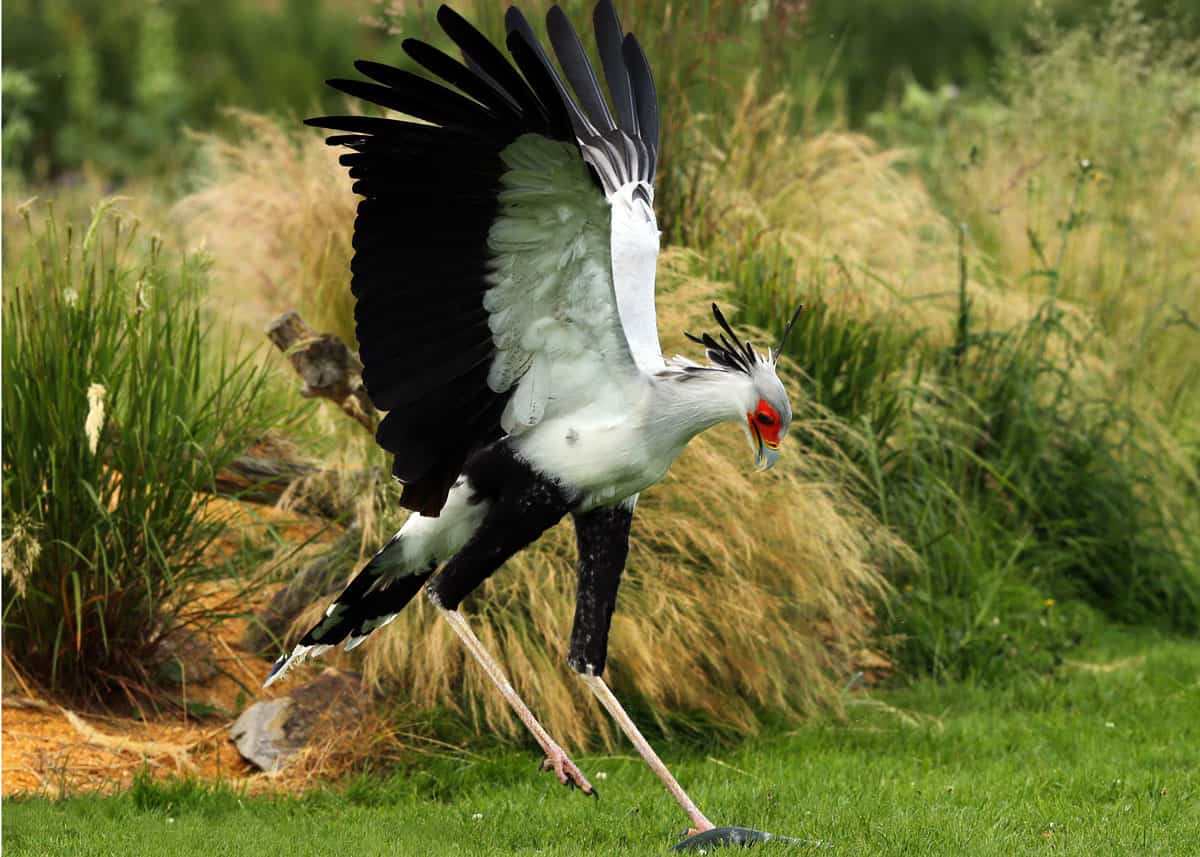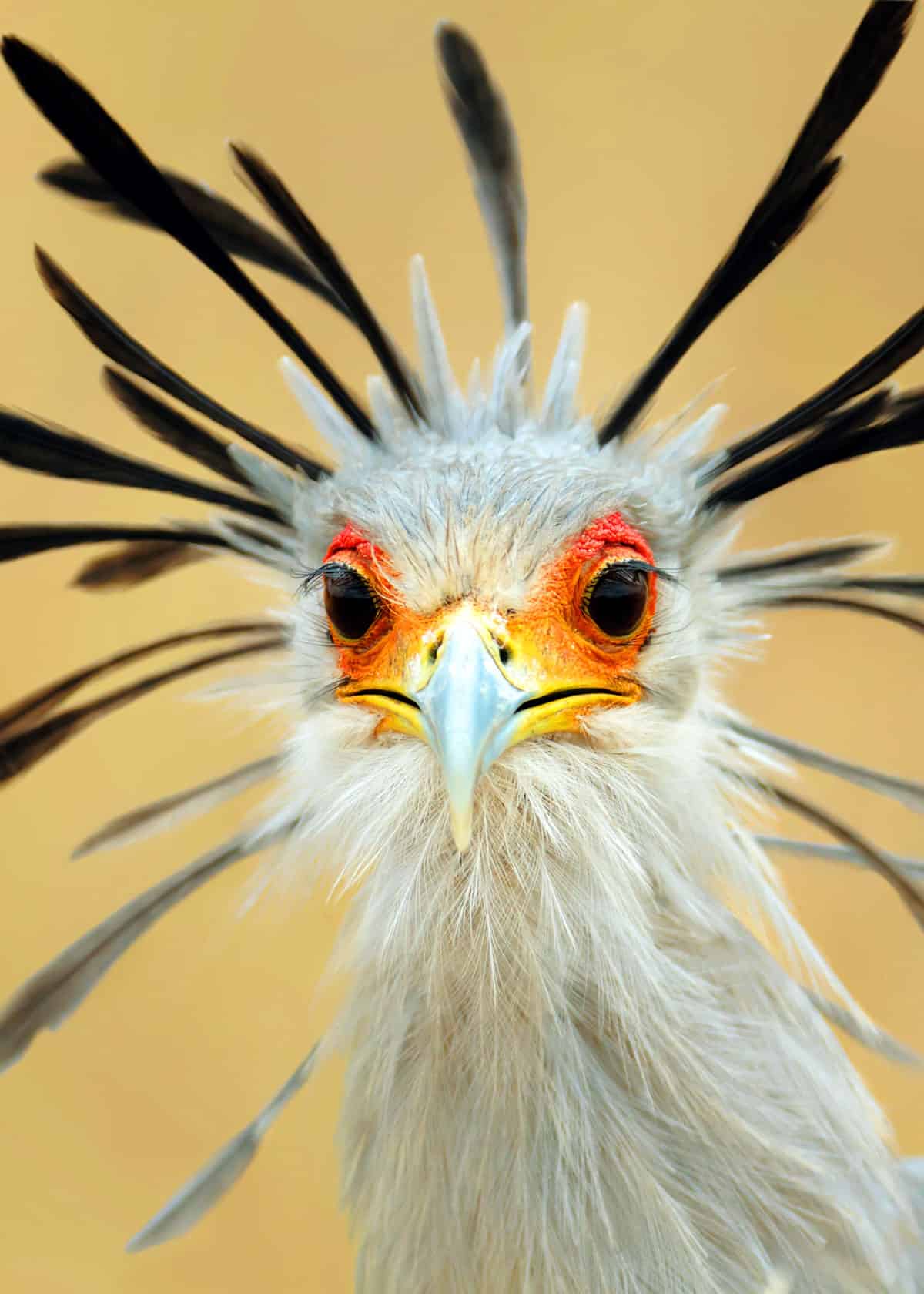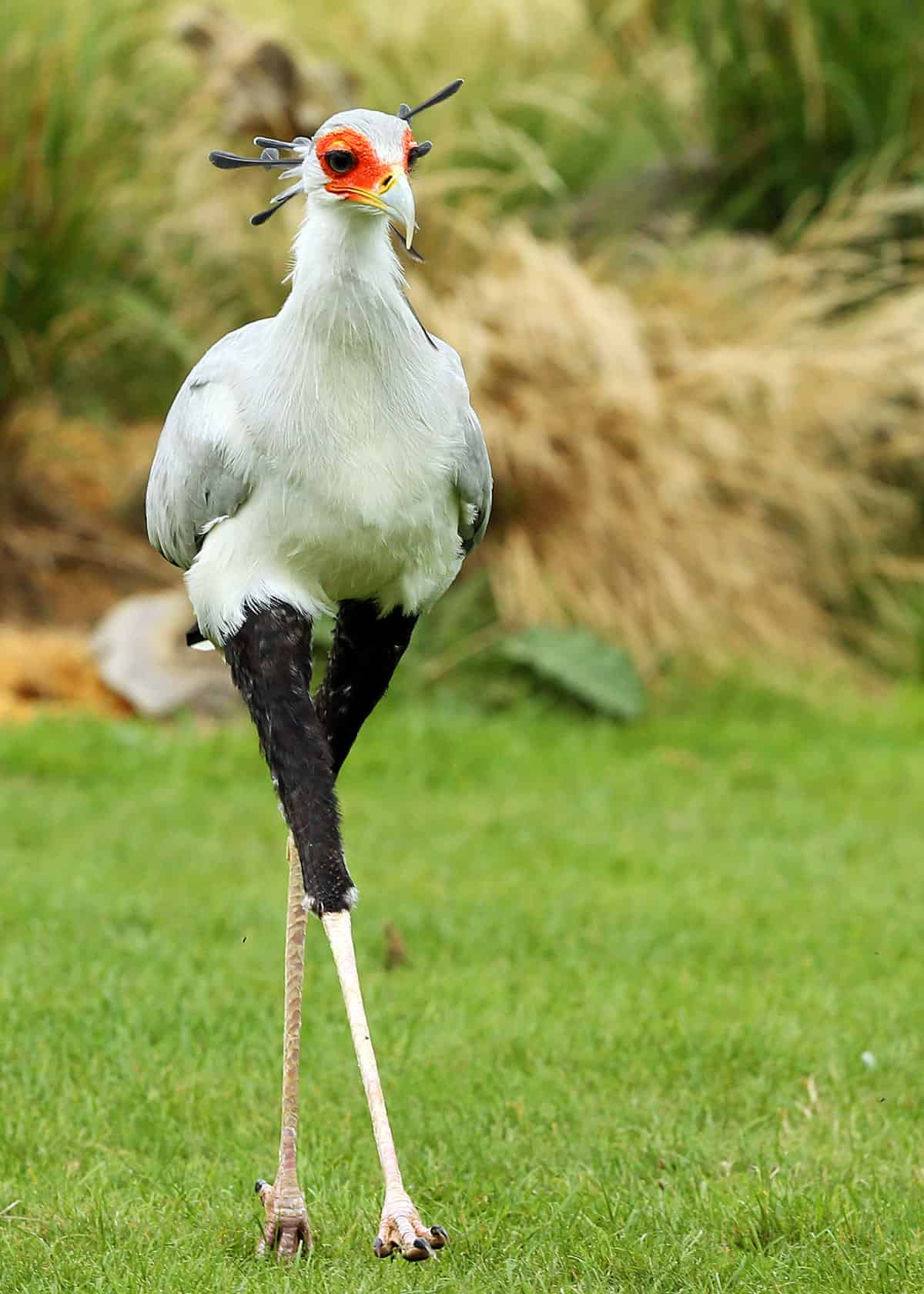If you take a look at a secretary bird, it might seem like someone put together some crazy combination of a chicken and a velociraptor – and you might have a few questions. Get all the answers you need with these secretary bird facts!

Table of Contents
25 Facts About Secretary Birds
1. How did the secretary bird get its name?
There are a couple of takes on this. One is that the secretary bird looks like an old-fashioned secretary, owing to the quill-like feathers at the back of its head, the light grey feathers resembling a long tailcoat, and the dark grey/black feathers resembling britches.
The other possible naming method is a little simpler and may have origins in the Arabic language. The pronunciation of secretary bird is similar to the Arabic phrase saqr-et-tair, which translates roughly to “hunter bird.”
2. What is the secretary bird’s Latin name?
The secretary bird’s Latin name is Sagittarius serpentarius. This translates to “archer of serpents.” The secretary bird was aptly named for it’s hunting ability and diet.
3. How long does a secretary bird live?
About 10-15 years in the wild and sometimes a few years longer in captivity.
4. Where do secretary birds live?
Secretary birds are found in Sub-Saharan Africa, usually in open areas. They can be found at elevations anywhere from sea level to almost 10,000 feet above!
5. What is the secretary bird’s habitat?
Secretary birds like open lands where prey has less chance to hide. They like savannas and grasslands the most, but also live in areas that are mostly desert with a few trees nearby to build their nests.
Sometimes they’re found in recently burned areas where their prey is easy to come by.
6. What eats a secretary bird? Predators and Threats
Nothing really eats the secretary bird. Although other predatory bird species like crows, ravens, and owls will eat the eggs and young chicks.
The main threat to secretary birds is human destruction.
7. Do secretary birds have eyelashes?
Not exactly. While secretary birds may look like they have long luscious eyelashes, these are actually small modified feathers without barbs.
But basically, yes. Secretary birds have very long eyelash-type things. The eyelashes grow in when they’re around three weeks old.
8. Do secretary birds fly?
Yes, secretary birds do fly but they prefer to stay on the ground. When they fly their legs stick straight out behind them like a heron or a crane.
9. Do secretary birds migrate?
Nope! But they are nomadic and can live in areas of about 20 square miles (up to 50 square kilometers).
10. How fast can a secretary bird run?
Secretary birds can run so fast that they’ve earned the nickname “devil’s horse.” There is no concrete number on max speed, but they do a lot of walking and they can travel up to 18 miles (30 kilometers) per day!
11. What do secretary birds eat? Snakes?
Yes, but that’s not all! Some of the snakes the secretary birds eat are venomous – like adders, cobras, and the black mamba.
Secretary birds also eat amphibians, lizards, and small animals like rodents and other birds.
12. How does the secretary bird hunt?
Of all of the secretary bird facts, this one may be the most interesting. Secretary birds have an incredible way of hunting that allows them to devour the venomous snakes they like to eat.
These birds hunt on foot and stomp on the ground to expose prey. Once it spots its next meal, the secretary bird will stomp on a snake with a force about 5 times its body weight.
After it’s stomped on the snake the secretary bird throws it high into the air to stun it before pecking it for good measure.
All the while, the secretary bird uses its wings as protection from potential bites by flapping to distract its prey.
These techniques are generally reserved for difficult and dangerous animals like snakes. Smaller prey like lizards and rodents are eaten whole upon catching them.
Check out our post on essential birding gear
13. Do secretary birds hunt together or by themselves?
Both, kind of. Secretary birds prefer to hunt alone but they do exist in pairs. When they’re not mating or nesting, each half of a pair will go off on their own to hunt and do their own thing.
They’re pretty solitary birds, and they don’t flock or gather. In fact, there are often several kilometres between two birds.
14. How tall is a secretary bird?
About 4 to 4.5 feet tall. The males tend to be a little taller than the females but at their max height, they’re about the size of the average 10-year-old.
Most of their height is attributed to their long legs.
15. How much do secretary birds weigh?
About 5 to 11 pounds (2.3 to 5kg). Males are a little heavier, but the females pack quite a punch (or a stomp) too.
16. What is the secretary birds wingspan?
A secretary bird’s wingspan can reach almost 7 feet (2 meters) wide! This comes in handy for hunting and courtship rituals.
17. Why is the secretary bird important?
Secretary birds are the only members of the family Sagittariidae. They’re a unique bird of prey, with their height and diet, and they are one of few terrestrial raptors, which means they walk more than they fly.
They’re one of the most skilled snake hunters out there, and they have a special technique for hunting that keeps them from harm while they strike their venomous prey.
18. What sound does the secretary bird make?
Secretary birds are mostly silent predators and they rarely make a sound.
Of course, the young will be more vocal when they’re hungry, but this gets less frequent the older they get.
Adult secretary birds – while they seldom call – have an unusual sound.
Their call is more like a deep croaking that sounds more like a frog than the call of a bird. This call is very loud and can be heard over great distances. They use their calls mostly in courtship rituals when a male is trying to find a female to mate with.
19. What does the secretary bird symbolize on the coat of arms?
The secretary bird appears on South Africa’s coat of arms, holding the image of the setting sun between outstretched wings. In the image, the secretary bird symbolizes protection and is considered a divine messenger bird, as noted with its gold color in the seal.
In coordination with the rest of the coat of arms which displays the sun, the King Protea (South Africa’s national flower), the shield surrounding two men, wheat, and elephant tusks, the secretary bird provides a connection between earth and the heavens.
The secretary bird looks like it’s hatching from the tusks and ascending upward, symbolizing the birth and successful growth of a nation.
The secretary bird is also featured on Sudan’s national logo and its flag as a symbol of victory.
20. What else does the secretary bird symbolize?
The secretary bird has plenty of symbolic connotations. There are protection and victory, and because of this, the bird can serve as a fitting image for a country’s values.
It also stands for family bonds, pride, and decisiveness. After all, when you’re hunting venomous snakes, there isn’t much time for indecision is there?
21. Where does the secretary bird nest?
Secretary birds nest in acacia trees, which grow in the savannas and grasslands of Sub-Saharan Africa. They keep the same nest for years and as time goes on it only gets bigger.
The nest is built in a way that’s similar to an eagle’s nest. They’re about 8 feet (2.5 meters) wide and a foot (30 centimetres) deep.
22. Are secretary birds monogamous?
Yes! Secretary birds mate for life after a dramatic courtship ritual (this is where their funny croak-calls come into play).
Males perform an elaborate flight pattern for the female, calling to her and showing off his aerial skill. The other part of the ritual is done on the ground.
The male and female secretary birds chase each other in a similar fashion to how they chase prey, with their wings held up high behind them.
23. How many eggs does the secretary bird lay?
The female secretary bird lays eggs in batches of 1 to 3, with each egg laid two or three days apart in the spring. The eggs are a white or pale green color and are a rough texture.
Both males and females incubate the eggs, though the majority is done by the female. The eggs are incubated for 42 to 46 days, and usually two out of the three chicks make it to adulthood. The youngest of the clutch often die of starvation.
24. How fast do secretary bird chicks grow?
Newly hatched chicks look kind of ugly. They have grey downy feathers and yellow faces. It takes about two months before they’re able to fly, though they can flap their wings after about 6 weeks.
25. Are secretary birds endangered?
No, but they are classified as vulnerable. Secretary birds have been a protected species since 1968, but they’re not immune to the effects of deforestation.
As a vulnerable species, they could become endangered if we aren’t careful.
Your Turn!
Did you enjoy learning about this amazing bird? What was your favorite fact? Anything we should add to this list? Have you seen these birds in person? Let us know in the comments, we love to hear from you!
Drew Haines is an animal enthusiast and travel writer. She loves to share her passion through her writing.
She graduated high school at sixteen and started her own business, Everywhere Wild Media. And she runs Everywhere Wild and JustBirding. She also guest blogs on Storyteller.Travel
She lived in Ecuador for 6 years and explored the Galapagos Islands. Currently based in N.S., Canada.




Andrew Galloway
Saturday 29th of April 2023
Excellent story Drew, I enjoyed reading your article. Keep up the great work you are doing and good luck to you.